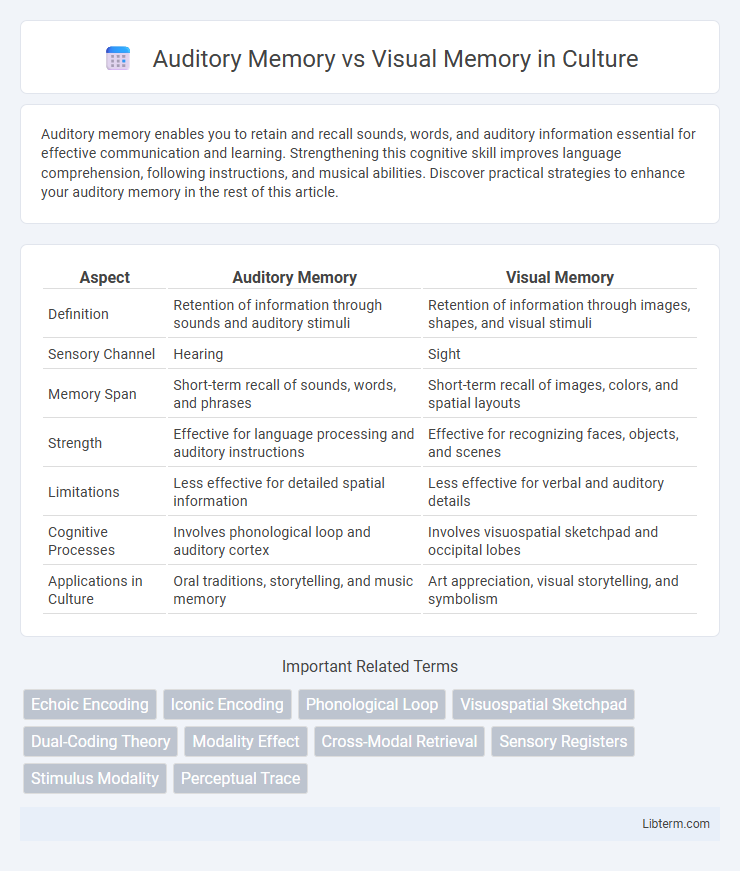Auditory memory enables you to retain and recall sounds, words, and auditory information essential for effective communication and learning. Strengthening this cognitive skill improves language comprehension, following instructions, and musical abilities. Discover practical strategies to enhance your auditory memory in the rest of this article.
Table of Comparison
| Aspect | Auditory Memory | Visual Memory |
|---|---|---|
| Definition | Retention of information through sounds and auditory stimuli | Retention of information through images, shapes, and visual stimuli |
| Sensory Channel | Hearing | Sight |
| Memory Span | Short-term recall of sounds, words, and phrases | Short-term recall of images, colors, and spatial layouts |
| Strength | Effective for language processing and auditory instructions | Effective for recognizing faces, objects, and scenes |
| Limitations | Less effective for detailed spatial information | Less effective for verbal and auditory details |
| Cognitive Processes | Involves phonological loop and auditory cortex | Involves visuospatial sketchpad and occipital lobes |
| Applications in Culture | Oral traditions, storytelling, and music memory | Art appreciation, visual storytelling, and symbolism |
Introduction to Auditory and Visual Memory
Auditory memory involves the ability to retain and recall information that is heard, such as sounds, words, and music, playing a crucial role in language comprehension and communication. Visual memory refers to the capacity to remember visual information, including shapes, colors, and spatial arrangements, essential for tasks like reading, navigation, and object recognition. Both sensory memory types engage distinct neural pathways, with auditory memory primarily linked to the temporal lobe and visual memory associated with the occipital lobe.
Defining Auditory Memory
Auditory memory refers to the brain's ability to process, store, and recall information that is heard, such as sounds, words, and verbal instructions. It plays a crucial role in language development, learning, and communication by enabling individuals to remember spoken information over short or long periods. Unlike visual memory, which relies on visual stimuli, auditory memory is essential for tasks like following directions, understanding conversations, and acquiring new vocabulary.
Defining Visual Memory
Visual memory is the cognitive ability to store, retain, and recall information seen in the environment, such as shapes, colors, faces, and spatial layouts. It plays a crucial role in tasks like reading, navigation, and recognizing objects by capturing and processing visual stimuli in the brain's occipital and temporal lobes. Unlike auditory memory, which involves remembering sounds and verbal information, visual memory primarily relies on the visual cortex and associated neural pathways for encoding and retrieval.
Key Differences Between Auditory and Visual Memory
Auditory memory primarily processes and stores information through sound, such as voices and music, while visual memory focuses on images, shapes, and spatial arrangements. Auditory memory relies heavily on the temporal lobe for sound recognition and retention, whereas visual memory engages the occipital lobe and parts of the parietal lobe involved in visual processing. The key differences include modality of input, neural pathways activated, and the types of information retained, making each memory type critical for different cognitive tasks.
How the Brain Processes Auditory and Visual Information
The brain processes auditory information primarily through the auditory cortex in the temporal lobe, where sound waves are converted into neural signals for interpretation and memory storage. Visual information is handled by the visual cortex located in the occipital lobe, transforming light signals into images and spatial data critical for visual memory formation. These distinct neural pathways enable the brain to efficiently encode, store, and retrieve auditory and visual memories based on different sensory inputs and processing mechanisms.
Strengths and Weaknesses of Auditory Memory
Auditory memory excels at processing and recalling sound-based information such as spoken language, melodies, and auditory sequences, providing an advantage in activities like language learning and music appreciation. However, it is vulnerable to interference from background noise and distractions, which can degrade retention and recall accuracy. Compared to visual memory, auditory memory tends to retain information for shorter durations and may struggle with complex or spatial data that visual memory handles more effectively.
Strengths and Weaknesses of Visual Memory
Visual memory excels at retaining detailed images, spatial information, and patterns, enabling strong recall of shapes, colors, and locations. However, it can struggle with retaining information over long periods without repetition and is less effective for remembering abstract or sequential data compared to auditory memory. Visual memory's reliance on imagery makes it vulnerable to distractions and less efficient in dynamic, verbally complex environments.
Factors Influencing Memory Type Preference
Individual differences such as age, cognitive style, and sensory processing impact preference for auditory or visual memory. Environmental factors including context, task demands, and stimulus complexity also determine which memory type is more effective. Neurobiological mechanisms, like working memory capacity and neural activation patterns in the auditory cortex or visual cortex, further influence memory type preference.
Practical Applications of Auditory and Visual Memory
Auditory memory plays a crucial role in language acquisition, allowing individuals to retain and process spoken information such as instructions, conversations, and music, which is essential in educational settings and communication-focused professions. Visual memory supports tasks that require pattern recognition, spatial awareness, and image retention, making it vital for activities like reading, map navigation, and design work. Understanding the strengths of auditory versus visual memory can enhance learning strategies, improve workplace efficiency, and aid in developing personalized cognitive training programs.
Enhancing Auditory and Visual Memory Skills
Enhancing auditory memory skills involves targeted exercises such as repeating sequences of sounds or participating in active listening activities, which strengthen the brain's ability to process and recall auditory information. Visual memory can be improved through techniques like visualization, pattern recognition, and spatial memory games that challenge the recall of images, shapes, and spatial arrangements. Consistent practice with tools like audio playback, flashcards, and memory palaces effectively boosts both auditory and visual memory capacities by engaging different cognitive pathways.
Auditory Memory Infographic

 libterm.com
libterm.com